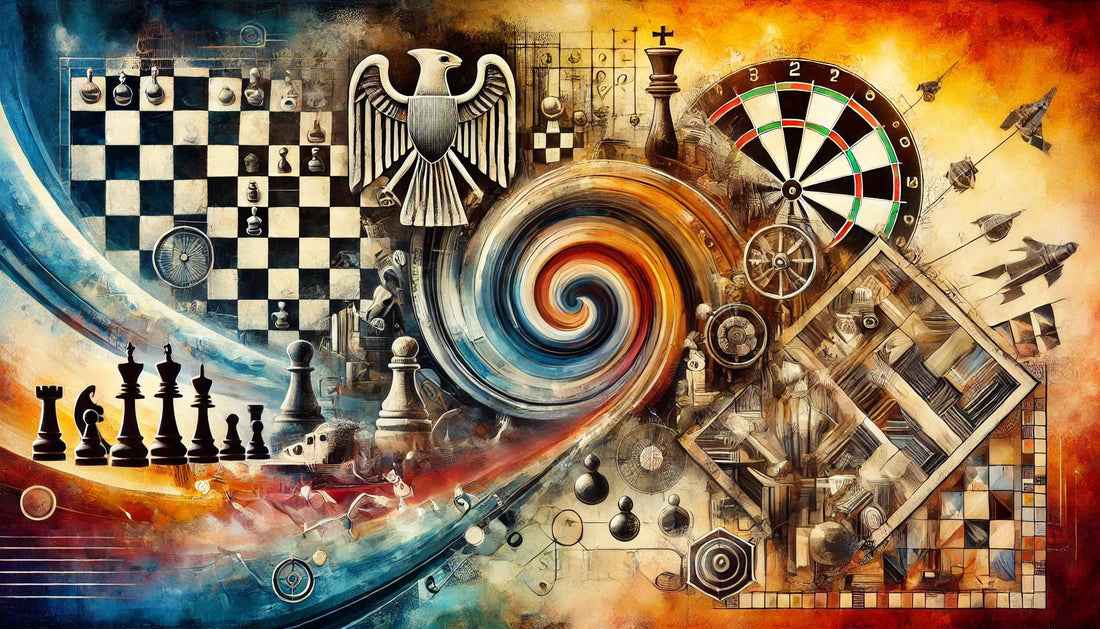
The Enchanting History of Board Games: From Ancient Senet to Modern Catan
Share
Chapter 1: The Dawn of Games - Senet and the Ancient World
In the land of the Pharaohs, where the Nile whispered secrets to those who listened, the first known board game, Senet, was born. Played over 5,000 years ago, this game of strategy and chance was more than mere entertainment; it was a reflection of the journey to the afterlife. Kings and commoners alike would maneuver their pieces along the game’s 30 squares, each move a step closer to the gods.
Senet, found in the tombs of ancient Egypt, represented the eternal struggle between good and evil, a spiritual dance on an ornate grid. Crafted from wood, faience, and ivory, these boards were treasures in themselves. The game’s rules, shrouded in mystery, have been partially reconstructed, allowing modern players to glimpse the ancient strategies that once captivated Egyptian minds.
Chapter 2: The Rise of the Dice - The Game of Ur and Beyond
Across the fertile crescent, in the cradle of civilization, the Royal Game of Ur emerged around 2600 BCE. Unearthed in the royal tombs of Ur, this game with its distinctive rectangular board and pyramid-shaped dice captivated players from Mesopotamia to the Indus Valley. It was a game of strategy, luck, and skill, with pieces racing to the finish line amidst moments of divine intervention.
The dice, an invention that revolutionized gaming, added an element of chance that would become a staple in board games across the ages. As the dice rolled, fate’s hand was revealed, making each game unpredictable and exciting. The clatter of dice on wood, the anticipation of the outcome, and the victory cries of players echoed through the annals of history.
Chapter 3: The Classics Take Shape - Chess and Go
Traveling eastward, we find ourselves in ancient India, where the game of Chaturanga, the precursor to chess, began its storied journey. Chaturanga, meaning "four divisions of the military," simulated the battlefield with its infantry, cavalry, elephants, and chariots. This game of war and strategy evolved, spreading across Persia and the Islamic world, transforming into Shatranj, and eventually becoming the chess we know today.
Meanwhile, in the land of the rising sun, another game of immense strategic depth was being refined. Go, originating in China over 2,500 years ago, captured the imagination of emperors and peasants alike. With its simple black and white stones, Go’s complexity lies not in the pieces but in the infinite possibilities of their placement. It is a game of encirclement, of balance, where each move weaves a tapestry of tactics and foresight.
Chapter 4: Medieval Merriment - The Age of European Board Games
As the medieval period unfurled its tapestry of knights and castles, Europe saw a blossoming of board games that would endure for centuries. The game of Nine Men’s Morris, with its roots in the Roman Empire, was a popular pastime among medieval peasants and nobility. Carved into wooden boards, etched in stone, and even scratched into the earth, it was a game of alignment and cunning.
Another favorite was the game of Tafl, a precursor to modern chess, played by the Vikings. With its asymmetric gameplay, where one player’s king and defenders attempted to escape from the besieging forces, Tafl mirrored the strategic challenges of warfare. The game boards, often beautifully crafted from wood and adorned with intricate carvings, were prized possessions.
Chapter 5: Renaissance Revelry - The Age of Enlightenment and Beyond
The Renaissance, a period of intellectual revival, also saw a resurgence in the popularity of board games. Backgammon, an ancient game dating back to Mesopotamia, experienced a renaissance of its own. Known for its blend of strategy and luck, backgammon boards became works of art, with exquisite inlays and craftsmanship.
The 18th century introduced the world to the Game of the Goose, a simple yet engaging race game that delighted children and adults alike. Played on illustrated boards depicting various themes, it was a precursor to modern family games. This era also saw the emergence of games that would lay the foundation for contemporary board gaming culture.
Chapter 6: The Golden Age of Board Games - The 19th and 20th Centuries
The 19th century marked a golden age for board games, with the advent of mass production making games accessible to a wider audience. In 1860, Milton Bradley’s The Checkered Game of Life became a household name, teaching players moral lessons through its gameplay. Around the same time, Parker Brothers introduced games like Monopoly, which would become an iconic part of board game history.
The 20th century saw the rise of abstract strategy games like Scrabble and Clue, which combined wordplay and deduction with entertainment. These games not only challenged players intellectually but also fostered social interaction and family bonding.
Chapter 7: The Modern Renaissance - From Settlers to Catan
As the new millennium dawned, a modern renaissance in board gaming began. The Settlers of Catan, introduced in 1995 by Klaus Teuber, revolutionized the genre with its blend of strategy, resource management, and negotiation. Catan’s hexagonal board pieces, which can be rearranged for endless variability, captivated a new generation of gamers.
Catan’s success paved the way for a surge in board game innovation, leading to a diverse array of games that cater to every taste and interest. From cooperative games like Pandemic to deck-building games like Dominion, the modern era of board games is marked by creativity and inclusivity.
Chapter 8: The Digital Age - Board Games in the Virtual Realm
In the 21st century, the digital revolution transformed the landscape of board gaming. Online platforms and mobile apps brought classic and modern board games to virtual tables, connecting players across the globe. This digital shift not only preserved the essence of traditional board games but also introduced them to new audiences.
Games like Tabletop Simulator and Board Game Arena provide virtual spaces where players can gather, roll digital dice, and move virtual pieces with the same excitement as their physical counterparts. This fusion of technology and tradition has ensured that the magic of board games continues to thrive in the digital age.
Epilogue: The Timeless Allure of Board Games
From the sands of ancient Egypt to the virtual tables of the digital era, board games have enchanted and entertained humanity for millennia. They are more than mere pastimes; they are a testament to our creativity, our desire for connection, and our love of storytelling and strategy.
Whether it's the strategic depths of chess, the unpredictable adventures of Monopoly, or the collaborative challenges of Catan, board games offer a portal to worlds both real and imagined. As we gather around the table, rolling dice and moving pieces, we partake in a tradition as old as civilization itself—a tradition that promises to endure, evolve, and enchant for generations to come.
